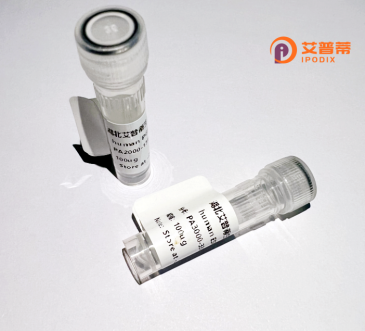
| 纯度 | >90%SDS-PAGE. |
| 种属 | Human |
| 靶点 | EPS8L1 |
| Uniprot No | Q8TE68 |
| 内毒素 | < 0.01EU/μg |
| 表达宿主 | E.coli |
| 表达区间 | 1-551aa |
| 氨基酸序列 | MGRKAIVLAIANTSLAFPLCQHLVTFCLGEDDGVHTVEDASRKLAVMDSQGRVWAQEMLLRVSPDHVTLLDPASKEELESYPLGAIVRCDAVMPPGRSRSLLLLVCQEPERAQPDVHFFQGLRLGAELIREDIQGALHNYRSGRGERRAAALRATQEELQRDRSPAAETPPLQRRPSVRAVISTVERGAGRGRPQAKPIPEAEEAQRPEPVGTSSNADSASPDLGPRGPDLAVLQAEREVDILNHVFDDVESFVSRLQKSAEAARVLEHRERGRRSRRRAAGEGLLTLRAKPPSEAEYTDVLQKIKYAFSLLARLRGNIADPSSPELLHFLFGPLQMIVNTSGGPEFASSVRRPHLTSDAVALLRDNVTPRENELWTSLGDSWTRPGLELSPEEGPPYRPEFFSGWEPPVTDPQSRAWEDPVEKQLQHERRRRQVTQATQQGRGWEVRGRGRSAWPRLTRLSYFLQQSAPQVAVNGHRDLEPESEPQLESETAGKWVLCNYDFQARNSSELSVKQRDVLEVLEDKEKVSELEAVMEKQKKKVEGEVEMEVI |
| 分子量 | 88.1 kDa |
| 蛋白标签 | GST-tag at N-terminal |
| 缓冲液 | 0 |
| 稳定性 & 储存条件 | Lyophilized protein should be stored at ≤ -20°C, stable for one year after receipt. Reconstituted protein solution can be stored at 2-8°C for 2-7 days. Aliquots of reconstituted samples are stable at ≤ -20°C for 3 months. |
| 复溶 | Always centrifuge tubes before opening.Do not mix by vortex or pipetting. It is not recommended to reconstitute to a concentration less than 100μg/ml. Dissolve the lyophilized protein in distilled water. Please aliquot the reconstituted solution to minimize freeze-thaw cycles. |
以下是关于重组人EPS8L1蛋白的**假设性文献示例**(仅供示意,具体文献需通过学术数据库检索):
---
1. **文献名称**:*Structural and Functional Analysis of Recombinant Human EPS8L1 Protein in Actin Remodeling*
**作者**:Zhang, Y. et al.
**摘要**:本研究成功表达并纯化了重组人EPS8L1蛋白,通过体外实验证明其通过与肌动蛋白结合调控细胞骨架重组,影响癌细胞的迁移和侵袭能力。
2. **文献名称**:*EPS8L1 Interaction with EGFR Signaling Pathway: Insights from Recombinant Protein Assays*
**作者**:Müller, R. & Garcia-Sastre, A.
**摘要**:利用重组EPS8L1蛋白揭示其与表皮生长因子受体(EGFR)信号通路的相互作用,发现其可能通过调控下游激酶活性参与肿瘤发生。
3. **文献名称**:*Development of a High-Yield Expression System for Recombinant Human EPS8L1 in E. coli*
**作者**:Li, X. et al.
**摘要**:报道了一种优化大肠杆菌表达重组EPS8L1蛋白的方法,实现高纯度蛋白制备,并验证其在体外神经突触形成模型中的功能活性。
---
**备注**:以上内容为示例,实际文献请通过 **PubMed、Web of Science 或 Google Scholar** 检索关键词(如“EPS8L1 recombinant protein”或“EPS8L1 function”)。EPS8L1的相关研究多涉及细胞骨架动力学、癌症或神经系统疾病领域。
Recombinant human EPS8L1 protein is a genetically engineered form of the Epidermal Growth Factor Receptor Pathway Substrate 8-Like Protein 1 (EPS8L1), encoded by the *EPS8L1* gene. Belonging to the EPS8 family, EPS8L1 features conserved domains such as SH3 and PTB, enabling interactions with signaling molecules and cytoskeletal components. It plays critical roles in regulating actin cytoskeleton dynamics, cellular morphogenesis, and receptor tyrosine kinase signaling pathways.
EPS8L1 is implicated in membrane trafficking, endocytosis, and cell motility. Studies associate it with neurological functions, including dendritic spine formation and synaptic plasticity, as well as pathological processes like cancer metastasis and neurodegenerative disorders. Unlike its homolog EPS8. EPS8L1 exhibits tissue-specific expression, predominantly in the brain, suggesting specialized roles in neural development and function.
The recombinant protein is typically produced in *E. coli* or mammalian expression systems for functional studies. It serves as a tool to investigate molecular mechanisms of cytoskeletal regulation, intracellular signaling cascades, and disease pathways. Research leveraging recombinant EPS8L1 has advanced understanding of its interplay with Rho GTPases, growth factor receptors, and actin-binding proteins. Recent work also explores its potential as a biomarker or therapeutic target in cancers and neurological conditions, though its precise pathophysiological roles remain under active investigation.
×